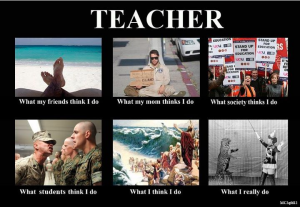In the beginning of our journey together, I was starting at a very solipsistic point. I was thinking that hey, I’m not using Twitter like so many of my colleagues. I want to learn how to do that well. I had already created class blogs, with glaring holes, and was completely willing to “remedy those later,” while I flitted off to another platform, another process. Ironically, in the first day questionnaire, I had said that “I hope to take the time to specialize and work towards mastery in one area, one resource, rather than flitting from new tool to new tool.” By the end of week two, I was finally able to pause and to see. To pause, unlearn and relearn, and to pause long enough to be magnetically drawn to the why. The why, not simply a resource or tool, but that all of it is for the students, for the emerging and vital literacies (old and new), and for their empowerment for their own future. Further, with this open-eyed, collaboratively-created motivation I decided to utilize aspects of social media to make this possible. However, my new virtual classroom, is only one aspect, one hub of the learning experiences I am re-envisioning.
I started in weebly with a blank slate, with two main guiding dispositions in mind: foster collaborative learning in digital and physical, and to promote student ownership and empowerment of their learning.
I will continue to utilize the classroom hub as I had before in some aspects, such as:
- Communication with students, parents and tutors
- Sharing resources (adapted, enriched, independent, etc.) for students’ learning
- As an archive of student learning experiences
- Promote multiliteracy skills
- Strengthen critical thinking skills, personal reflection and communication skills
However, starting with a blank slate, I designed for change, for collaboration and student ownership in the following ways:
- Sync student-creating learning blogs in which they will share their personal reflections and critical inquiries, as well as various creative endeavors throughout. This will be done in partnership with our physical portfolio (because we will still be making numerous experimental physical creations, such as mobiles, paintings, life-size character “body biographies” and many more). Further, like the cumulative total in LLED 447 I hope that together my classes will have a virtual and physical mass of learning, equivalent to numerous dissertations on their learning. We will culminate this with a portfolio gala (physical and virtual) for family, friends, teachers and for themselves.
- I’ve designed a peer feedback process modeled after our class’s peer contributions. I intend to model this process and scaffold students through it until it is natural, organic and truly collaborative growth.
- I am aiming for true collaboration and connectivity: I have designed to use the blog comment options on each class’s blog homepage much like we have in our UBC Group Forums. It will be a forum for ongoing, messy processing that synthesizes class-wide ideas, links and initial thoughts or questions.
- I’ve attached a Discussion Forum, open for students and parents to contribute recommendations, questions, and to promote more talking with rather than talking at. I need to continue to explore formatting options a more enticing and welcoming model. I’m not currently content with the weebly element options for this.
- Altered layout: made the space more visually communicative through slideshows, videos and infographics, hoping students would be drawn in and engaged. Also, I tried to contain our vast learning explorations into sub-pages so that students could navigate as they need and not feel overwhelmed, as they may have in the long drawn out Blogger fashion I had before.
- Not just student work showcase, student publishing. Through this course it has been apparent the importance of “filling the digital space,” of influencing public perceptions and building public knowledge, and so I wanted to do this not simply from me, but from my students. This will help broaden perspectives and deepen understanding for them, their parents and hopefully the public, like this course has done for us through our active inquiry, connecting and publishing.
- Genius Hour: Thanks to Jordan I think many of us will be pursuing just how to purposefully execute such passionate, student-driven inquiry. I too am in the process of curating resources and designing the practices and logistics so my students may also participate in this inspirational process.
- Permission forms, informing and connecting with parents. I am creating necessary informative permission forms that communicate with parents how and why we are using student blogs, as well as attempting to draw parents into our connected hub through RSS feed, email, and a periodic class newsletter.
Overall, this is only the beginning. I have learnt so much from LIBE 477, and I am still trying to truly see all the pieces and bring them together in my cracked open mind, but it’s an optimistic beginning. I look forward to the winding road ahead.
My work in progress can be found here: http://msbertrandsclass.weebly.com/ Although I’ve added to all pages in some form, the homepage, English 11 and Socials 10 have the most significant progress. Thanks for joining me on this journey LIBE 477 comrades!

